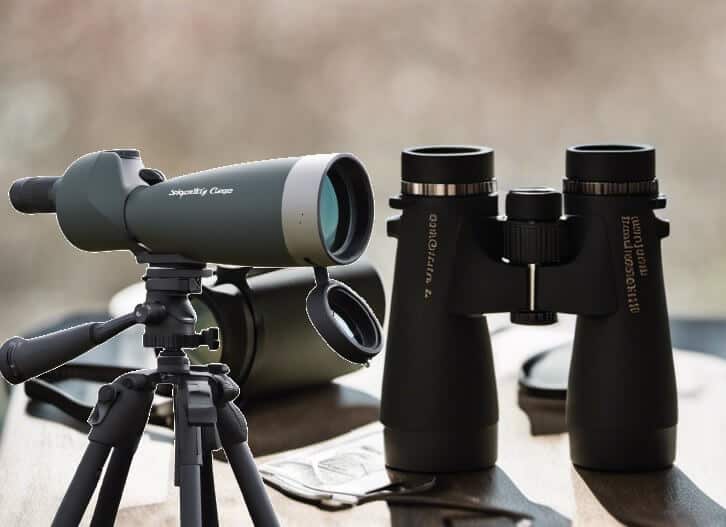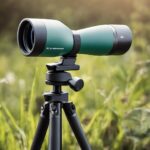Bird watching is a popular pastime that allows enthusiasts to appreciate the beauty and diversity of our avian friends. Binoculars vs. spotting scopes are often debated among bird watchers and yet it is one of the decisions a bird watcher must make. Binoculars and spotting scopes are two popular choices, each with its own set of benefits and limitations.
Binoculars
Binoculars are essential as they allow us to look at birds closer without disturbing them in their natural habitats. Binoculars are known for their portability and versatility, allowing birders to scan the landscape for flying or perching birds easily. On the other hand, spotting scopes offer the advantage of higher magnification and a more steady, stable view, which can be particularly useful for observing birds at greater distances or those that hold still for long periods.
Binoculars come in various sizes and weights, and a compact and lightweight design can contribute significantly to their portability, which is particularly important when bird watching, as you want to avoid carrying heavy equipment while tracking birds.
Compact binoculars are typically easier to handle and ideal for bird watchers on the move, while full sized binoculars offer better optics and brighter images, although they tend to be heavier.
One notable advantage of binoculars over spotting scopes is their ease of use for handheld viewing. Due to their lightweight design and wide field of view, binoculars enable us to quickly locate and follow birds without needing a tripod or other support equipment. In contrast, spotting scopes require a stable surface and an angled view, making real time observation more challenging.
Binoculars also provide binocular vision, meaning they deliver a three dimensional image to our eyes, which can help make it easier to judge distances and sizes.
Our guide Binoculars For Bird Watching is an excellent resource if you want to purchase binoculars.
Spotting Scopes
Spotting scopes are invaluable as their higher magnification and larger objective lens offer a detailed and bright view of our feathery friends, even from long distances.
The eyepiece plays a critical role in our viewing experience. Most spotting scopes feature interchangeable eyepieces with varying magnification and zoom capabilities, allowing us to choose the most suitable one for our particular bird watching situation. A higher magnification is excellent for long distance viewing, but it may also decrease the field of view.
There are two primary types of spotting scopes: straight and angled. Straight scopes offer a more natural and straightforward alignment for beginners, making it easier to locate birds. However, angled scopes can be more comfortable for extended observation periods, allowing us to look from various positions. A spotting scope requires a sturdy tripod to maintain image stability. Even a slight movement can cause a blurry view.
Spotting scopes are often more durable and waterproof than binoculars, as they are designed to withstand outdoor conditions.
Our guide Spotting Scopes For Bird Watching can assist you if you want to purchase a spotting scope.
Comparing Binoculars Vs. Spotting Scopes in Bird Watching
We often find ourselves deciding between binoculars and spotting scopes. Both tools have their advantages and disadvantages.
Binoculars are highly versatile and popular among bird watchers. They offer a wide field of view, enabling us to locate birds quickly. Binoculars are lightweight and easy to carry, an essential feature for treks through the great outdoors.
However, spotting scopes offer some benefits that binoculars do not. A spotting scope provides higher magnification, which helps identify birds at longer distances. They also have larger lenses, allowing more light to enter and producing clearer and brighter visual results. Spotting scopes are often tripod-mounted, which provides stability while viewing wildlife. This fixed position may limit their versatility compared to binoculars but allows for more comfortable and extended observation periods.
Below is a table highlighting the pros and cons of binoculars and spotting scopes.
Pros And Cons Of Binoculars Vs. Spotting Scopes Table
| BINOCULARS | |
|---|---|
| PROS | CONS |
| Allow for more detailed observation of birds | Can be more difficult to use in confined spaces |
| Allow for more precise focusing | May cause eye fatigue with prolonged use |
| Allow for quick and easy scanning of large areas | May cause more eye fatigue with prolonged use |
| Can be used by beginners and experienced bird watchers alike | May not be suitable for birding in areas with dense foliage |
| Can be used for a variety of outdoor activities | May not be suitable for birding in areas with extreme temperatures |
| Can be used for birding in areas with dense foliage | May not be suitable for birding in areas with fast-moving birds |
| Can be used for birding in areas with fast-moving birds | May not be suitable for birding in areas with glare or direct sunlight |
| Can be used for birding in urban or suburban environments | May not be suitable for birding in areas with high humidity or precipitation |
| Can be used for close-range and mid-range viewing | May not be suitable for birding in areas with high winds or strong currents |
| Can be used for extended periods without causing fatigue | May not be suitable for birding in areas with low light conditions |
| Can be used for long-range viewing | May not be suitable for birding in areas with reflective surfaces |
| Can be used in a variety of weather conditions | May not be suitable for birding in areas with small or distant birds |
| Can be used with a camera for digiscoping | May not be suitable for birding in open areas with distant birds |
| Can be used with glasses | May not be suitable for long-range viewing |
| Don't require a tripod or other support | May not provide enough detail for identifying certain species |
| Easy to use | Require a tripod or other support for steady viewing |
| Lightweight and portable | Limited magnification compared to spotting scopes |
| More affordable than spotting scopes | May not be as effective for birding in large open spaces. |
| Provide a wide field of view | May not provide enough detail for identifying certain species |
| SPOTTING SCOPES | |
|---|---|
| PROS | CONS |
| Allow for more detailed observation of birds | Heavier and bulkier than binoculars |
| Allow for more precise focusing | Require a tripod or other support for steady viewing |
| Better suited for birding in open areas | May be more expensive than binoculars |
| Can be used for birding in areas with distant birds | Can be more difficult to use for beginners |
| Can be used for birding in areas with extreme temperatures | Can be more difficult to focus on moving birds |
| Can be used for birding in areas with fast-moving birds | May cause more eye fatigue with prolonged use |
| Can be used for birding in areas with glare or direct sunlight | May not be suitable for birding in areas with fast-moving birds |
| Can be used for birding in areas with high humidity or precipitation | May not be suitable for birding in wet or foggy conditions |
| Can be used for birding in areas with high levels of noise or disturbance | May not be suitable for birding from a moving vehicle |
| Can be used for birding in areas with high winds or strong currents | May not be suitable for birding from a stationary position |
| Can be used for birding in areas with low light conditions | May not be suitable for birding in urban or suburban environments |
| Can be used for birding in areas with reflective surfaces | May not be as portable as binoculars |
| Can be used for birding in areas with small or distant birds | May require more time to set up and adjust |
| Can be used for birding in low light conditions | May not be as versatile as binoculars for other outdoor activities |
| Can be used for birding in wet or foggy conditions | May require additional accessories for optimal performance |
| Can be used for long-range viewing | May not be suitable for birding in areas with dense foliage |
| Can be used with a camera for digiscoping | May not be suitable for birding in areas with small or distant birds |
| Offer better image clarity and brightness | May not be suitable for birding in areas with low light conditions |
| Provide a higher magnification than binoculars | May not be as durable as binoculars in harsh outdoor conditions. |
Quick Tips To Use Binoculars Vs. Spotting Scopes For Bird Watching
Tips For Binocular Use:
- When using binoculars, first locate the bird with your naked eye, then raise the binoculars to your eyes and focus on it. This method ensures you keep sight of the bird while trying to find it through the binoculars.
- For bird watching, use binoculars with 8x or 10x magnification. Look for binoculars with a wide field of view and good close focus distance.
- Make sure to adjust the focus of your binoculars before using them, as this will help you get a clear and sharp image of the bird you’re watching.
- Keep both eyes open while using binoculars to help you maintain your depth perception and make it easier to follow the bird’s movements.
Tips For Spotting Scope Use:
- Spotting scopes come into play for longer distances and more detailed viewing. Spotting scopes are ideal for observing birds perched on distant trees or exploring wildlife in a given area. They often have a higher magnification (20x to 60x) and larger objective lens, allowing for better light transmission and clearer images.
- Set up your spotting scope on a tripod for stability, as this will significantly reduce the jittery effect often caused by high magnification.
- Choose your desired zoom level and adjust the focus until the image is sharp. Spotting scopes also have the advantage of adjustable eye relief, providing comfortable viewing even for eyeglasses.
- Instead of looking for a specific bird, scan the area for movement or colour contrasts. Once you spot a bird, follow its movements and observe its behaviour.
Final Thoughts
In the realm of bird watching, both binoculars and spotting scopes have their advantages and disadvantages. Knowing which tool to choose depends on personal preference, intended wildlife subjects, and the environment you plan to bird watch. Owning both devices gives the perfect balance and flexibility for all bird watching scenarios. We can select the ideal optical instrument by understanding our priorities and considering various factors such as mobility, magnification, and ease of use.
Frequently Asked Questions
What are the advantages of using a spotting scope over binoculars?
The advantages of using a spotting scope over binoculars include higher magnification, better light-gathering capabilities, and advanced features.
Are there situations where binoculars are more suitable than spotting scopes?
Yes, binoculars are often more suitable for birding situations that require quick and frequent changes in the viewing direction, such as in dense forests or when tracking fast-moving birds.
When is it more appropriate to use a spotting scope rather than binoculars?
A spotting scope can be more appropriate for bird watching when higher magnification is needed or when observing birds over longer distances, such as at wetlands or on open plains.






